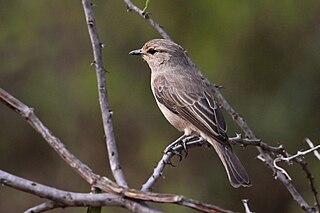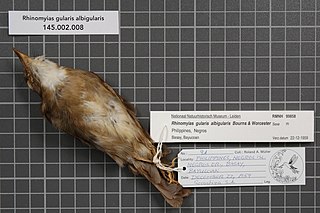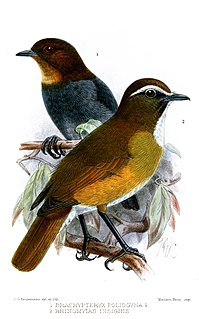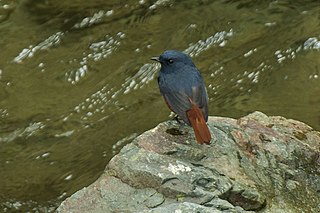
The chat flycatcher is a small passerine bird in the Old World flycatcher family Muscicapidae that is native to southern Africa.

The Marico flycatcher or Mariqua flycatcher is a passerine bird in the Old World flycatcher family Muscicapidae that is found in areas of southern Africa.

The African grey flycatcher, grayish flycatcher, or large flycatcher is a passerine bird in the Old World flycatcher family Muscicapidae that occurs in parts of East Africa.

The pale flycatcher is a passerine bird of the Old World flycatcher family Muscicapidae, found in Sub-Saharan Africa.
The sombre rock chat is a species of passerine bird in the family Muscicapidae. It is found in Ethiopia and Somalia. Its natural habitat is subtropical or tropical dry shrubland.
The brown-tailed rock chat is a species of bird in the family Muscicapidae. It is found in Chad, Eritrea, Ethiopia, Kenya, Somalia, Sudan, and Uganda. Its natural habitats are dry savanna and subtropical or tropical dry shrubland.

The white-fronted black chat is a species of passerine bird in the family Muscicapidae. It is found in Benin, Burkina Faso, Cameroon, Central African Republic, Chad, Democratic Republic of the Congo, Ivory Coast, Eritrea, Ethiopia, Gambia, Ghana, Guinea, Guinea-Bissau, Mali, Mauritania, Niger, Nigeria, Senegal, Sierra Leone, South Sudan, Togo, and Uganda. Its natural habitats are moist savanna and subtropical or tropical dry shrubland.
The streak-breasted jungle flycatcher, also known as the streaky-breasted jungle-flycatcher or Buru jungle-flycatcher, is a species of bird in the Old World flycatcher family Muscicapidae. It is endemic to the island of Buru in Indonesia where it originally inhabited tropical forests at elevations between 500 and 1,500 metres.

The white-throated jungle flycatcher is a species of bird in the Old World flycatcher family Muscicapidae. It is endemic to the Philippines. The natural habitats of the white-throated jungle flycatcher are tropical moist lowland forests and tropical moist montane forests. It is threatened by habitat loss.

The brown-chested jungle flycatcher is a species of bird in the Old World flycatcher family Muscicapidae. It is found in Brunei, China, Hong Kong, Malaysia, Singapore, Thailand, and Tibet. Its natural habitats are subtropical or tropical moist lowland forests and subtropical or tropical mangrove forests. It is threatened by habitat loss.

The Sula jungle flycatcher is a species of passerine bird in the Old World flycatcher family Muscicapidae. It is endemic to Sula Island in Indonesia where its natural habitat is subtropical or tropical moist lowland forests. It is threatened by habitat loss.

The slaty-backed jungle flycatcher is a species of birds in the Old World flycatcher family Muscicapidae. It is endemic to the Philippines. The specific epithet honours the British zoological collector Walter Goodfellow. Its natural habitat is subtropical or tropical moist montane forests. It is becoming rare due to habitat loss.

The eyebrowed jungle flycatcher is a species of bird in the Old World flycatcher family Muscicapidae. It is endemic to the island of Borneo. The natural habitat of the eyebrowed jungle flycatcher is subtropical or tropical moist montane forests. It builds an open, mossy cup nest, generally in epiphytes or spiny palms.

The white-browed jungle flycatcher is a species of bird in the Old World flycatcher family Muscicapidae. It is endemic to Luzon island, in the Philippines. The natural habitat of the white-browed jungle flycatcher is tropical moist montane forests. It is threatened by habitat loss.

The fulvous-chested jungle flycatcher is a species of bird in the Old World flycatcher family Muscicapidae. It is found in Brunei, Indonesia, Malaysia, Myanmar, and Thailand. Its natural habitat is subtropical or tropical moist lowland forests.

The rufous-tailed jungle flycatcher is a species of passerine bird in the Old World flycatcher family Muscicapidae. It is found in Indonesia, Malaysia, and the Philippines. Its natural habitat is subtropical or tropical moist montane forests.

The grey-chested jungle flycatcher is a species of bird in the Old World flycatcher family Muscicapidae. It is found in Brunei, Indonesia, Malaysia, and Thailand. Its natural habitats are subtropical or tropical moist lowland forests and subtropical or tropical swamps. It is threatened by habitat loss.

The Luzon water redstart is a species of bird in the family Muscicapidae. It is endemic to the Philippines. Its natural habitats are subtropical or tropical moist lowland forest, subtropical or tropical moist montane forest, and rivers. It is threatened by habitat loss.

The Angolan cave chat is a small passerine bird in the Old World flycatcher family Muscicapidae. It used to be the sole member of the monotypic genus Xenocopsychus but was moved to Cossypha based on the results of a molecular phylogenetic study published in 2010. It occurs locally from western Angola to marginally south of the Kunene River in northern Namibia. Its natural habitat is rocky places in moist to dry savanna. It was previously described as being Near threatened, but has since been downgraded to Least concerned.
The Nicobar jungle flycatcher is a species of bird in the Old World flycatcher family Muscicapidae. It is endemic to the Nicobar Islands where its natural habitats are subtropical or tropical moist lowland forests and subtropical or tropical mangrove forests. It was at one time considered as a subspecies of the brown-chested jungle flycatcher.

















